Are Hydrangeas Poisonous to Cats?
Nothing spells summertime more than a vase of freshly picked hydrangeas from the garden. Those big showy blooms make for lovely cut flowers but if you have a kitty in the house or yard, you need to be careful since hydrangeas can be poisonous to cats.
How do cats get hydrangea poisoning?
According to Pet Poison Hotline, cats will become poisoned by eating any part of the hydrangea plant. The toxic component of the hydrangea is called cyanogenic glycoside. The flowers, leaves, buds, and stalks all contain the poison, but the buds and leaves contain the most toxin.
What are the symptoms of hydrangea poisoning in cats?
Like dogs, the most common symptoms of hydrangea poisoning in cats include:
Loss of appetite
Vomiting
Diarrhea
Painful belly
Depression
What should owners do if they suspect their cat has consumed hydrangeas?
If your cat has munched on any part of some hydrangea flowers, you likely need to contact your vet and watch for the signs of illness. Thankfully, cases of hydrangea poisoning are typically not too severe, says Dr. Michelle Burch, a licensed veterinarian.
However, the plant toxin can make your kitty sick, and it may require her to need supportive care from the vet. That could mean fluids, medications, or pain control may be necessary.
While your cat is recovering, she may also need a bland diet like cooked chicken, white rice, or plain yogurt.

How to prevent poisoning
If you have hydrangeas in the yard that your cat visits, you should figure out a way to prevent her from accessing the plants as much as possible. "Through the garden, place shells, branches, and thorny vines which are not appealing for a dog or cat to step on," says Dr. Burch. You can also try a few other tactics.
Botanical Oil Sprays
There are multiple products available as a non-toxic botanical oil spray, which can be applied around the edges of your garden or plants. "The botanical oils have a noxious smell for dogs and cats, causing a deterrent," says Dr. Burch.
Motion-Activated Sprinkler
A motion-activated sprinkler can be installed on the borders of your garden to help keep animals out. "When the sprinkler detects motion, it will give a spray in that direction to an unsuspecting intruder," says Dr. Burch.
Ultrasonic Deterrent
Ultrasonic deterrents can also be installed to detect movement. They emit an ultrasonic sound and may use light to scare away pets from certain areas of the yard or garden.
No matter which tactic you take to keep cats and hydrangeas separate, if you have a kitty who likes to munch on things like flowers and leaves, take precautions when it comes to growing, smelling, and enjoying the hydrangeas this summer.
As always, consult your vet with any and all questions.

